Dementia Care: Evidence-Based Approaches
VerifiedAdded on 2020/02/23
|14
|3571
|161
AI Summary
This assignment delves into the multifaceted aspects of dementia care, focusing on evidence-based practices. It examines the significance of social-professional networks in long-term care settings, investigates environmental risk factors associated with dementia, and explores interventions aimed at improving quality of life for individuals living with dementia. The document also highlights the role of palliative care in dementia management and discusses emerging technologies like mobile apps in healthcare.
Contribute Materials
Your contribution can guide someone’s learning journey. Share your
documents today.

Last Name 1
Assessment Task 3: Service Design
Student’s Name
Name of the Class
Professor’s Name
City
State
The Date
Assessment Task 3: Service Design
Student’s Name
Name of the Class
Professor’s Name
City
State
The Date
Secure Best Marks with AI Grader
Need help grading? Try our AI Grader for instant feedback on your assignments.
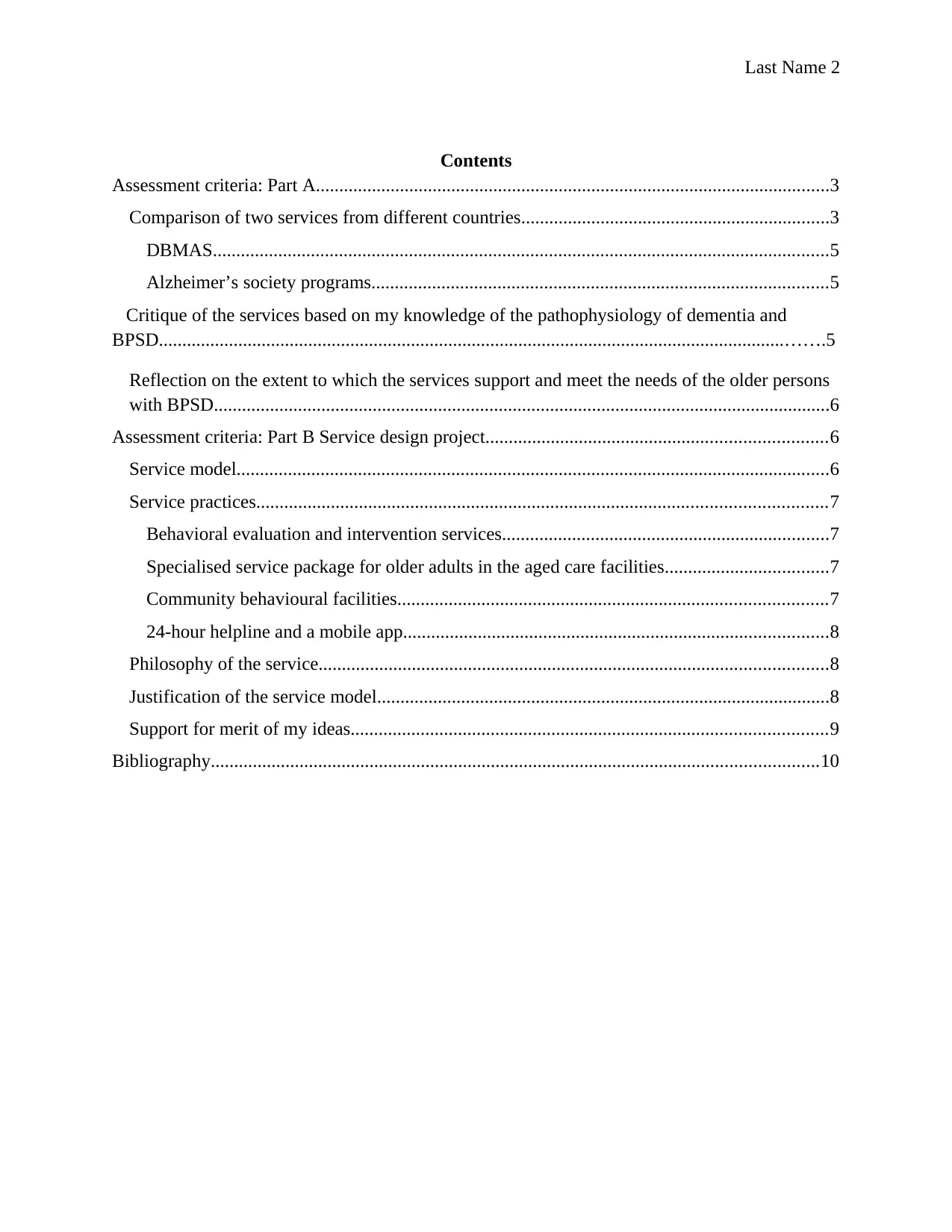
Last Name 2
Contents
Assessment criteria: Part A..............................................................................................................3
Comparison of two services from different countries..................................................................3
DBMAS....................................................................................................................................5
Alzheimer’s society programs..................................................................................................5
Critique of the services based on my knowledge of the pathophysiology of dementia and
BPSD......................................................................................................................................…….5
Reflection on the extent to which the services support and meet the needs of the older persons
with BPSD....................................................................................................................................6
Assessment criteria: Part B Service design project.........................................................................6
Service model...............................................................................................................................6
Service practices..........................................................................................................................7
Behavioral evaluation and intervention services......................................................................7
Specialised service package for older adults in the aged care facilities...................................7
Community behavioural facilities............................................................................................7
24-hour helpline and a mobile app...........................................................................................8
Philosophy of the service.............................................................................................................8
Justification of the service model.................................................................................................8
Support for merit of my ideas......................................................................................................9
Bibliography..................................................................................................................................10
Contents
Assessment criteria: Part A..............................................................................................................3
Comparison of two services from different countries..................................................................3
DBMAS....................................................................................................................................5
Alzheimer’s society programs..................................................................................................5
Critique of the services based on my knowledge of the pathophysiology of dementia and
BPSD......................................................................................................................................…….5
Reflection on the extent to which the services support and meet the needs of the older persons
with BPSD....................................................................................................................................6
Assessment criteria: Part B Service design project.........................................................................6
Service model...............................................................................................................................6
Service practices..........................................................................................................................7
Behavioral evaluation and intervention services......................................................................7
Specialised service package for older adults in the aged care facilities...................................7
Community behavioural facilities............................................................................................7
24-hour helpline and a mobile app...........................................................................................8
Philosophy of the service.............................................................................................................8
Justification of the service model.................................................................................................8
Support for merit of my ideas......................................................................................................9
Bibliography..................................................................................................................................10
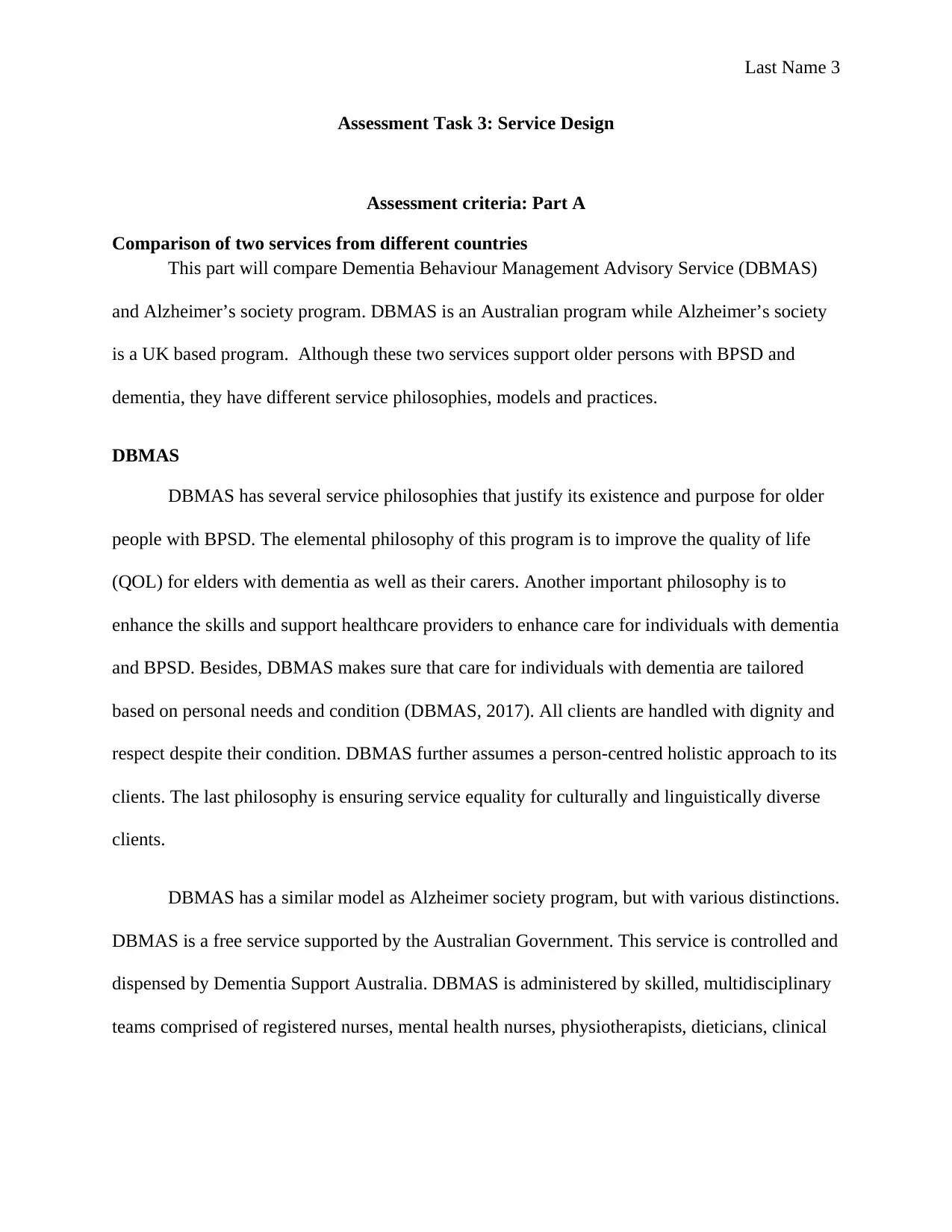
Last Name 3
Assessment Task 3: Service Design
Assessment criteria: Part A
Comparison of two services from different countries
This part will compare Dementia Behaviour Management Advisory Service (DBMAS)
and Alzheimer’s society program. DBMAS is an Australian program while Alzheimer’s society
is a UK based program. Although these two services support older persons with BPSD and
dementia, they have different service philosophies, models and practices.
DBMAS
DBMAS has several service philosophies that justify its existence and purpose for older
people with BPSD. The elemental philosophy of this program is to improve the quality of life
(QOL) for elders with dementia as well as their carers. Another important philosophy is to
enhance the skills and support healthcare providers to enhance care for individuals with dementia
and BPSD. Besides, DBMAS makes sure that care for individuals with dementia are tailored
based on personal needs and condition (DBMAS, 2017). All clients are handled with dignity and
respect despite their condition. DBMAS further assumes a person-centred holistic approach to its
clients. The last philosophy is ensuring service equality for culturally and linguistically diverse
clients.
DBMAS has a similar model as Alzheimer society program, but with various distinctions.
DBMAS is a free service supported by the Australian Government. This service is controlled and
dispensed by Dementia Support Australia. DBMAS is administered by skilled, multidisciplinary
teams comprised of registered nurses, mental health nurses, physiotherapists, dieticians, clinical
Assessment Task 3: Service Design
Assessment criteria: Part A
Comparison of two services from different countries
This part will compare Dementia Behaviour Management Advisory Service (DBMAS)
and Alzheimer’s society program. DBMAS is an Australian program while Alzheimer’s society
is a UK based program. Although these two services support older persons with BPSD and
dementia, they have different service philosophies, models and practices.
DBMAS
DBMAS has several service philosophies that justify its existence and purpose for older
people with BPSD. The elemental philosophy of this program is to improve the quality of life
(QOL) for elders with dementia as well as their carers. Another important philosophy is to
enhance the skills and support healthcare providers to enhance care for individuals with dementia
and BPSD. Besides, DBMAS makes sure that care for individuals with dementia are tailored
based on personal needs and condition (DBMAS, 2017). All clients are handled with dignity and
respect despite their condition. DBMAS further assumes a person-centred holistic approach to its
clients. The last philosophy is ensuring service equality for culturally and linguistically diverse
clients.
DBMAS has a similar model as Alzheimer society program, but with various distinctions.
DBMAS is a free service supported by the Australian Government. This service is controlled and
dispensed by Dementia Support Australia. DBMAS is administered by skilled, multidisciplinary
teams comprised of registered nurses, mental health nurses, physiotherapists, dieticians, clinical
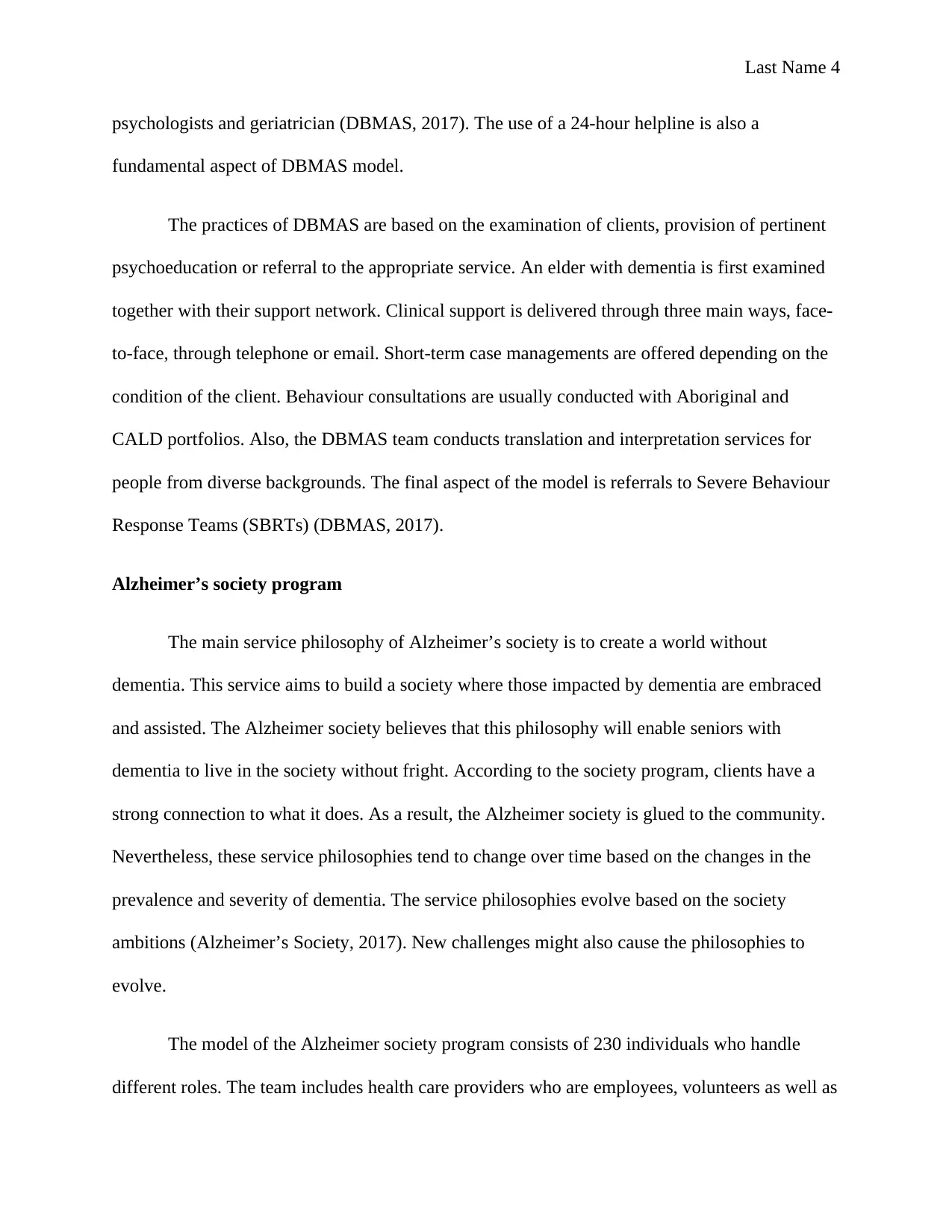
Last Name 4
psychologists and geriatrician (DBMAS, 2017). The use of a 24-hour helpline is also a
fundamental aspect of DBMAS model.
The practices of DBMAS are based on the examination of clients, provision of pertinent
psychoeducation or referral to the appropriate service. An elder with dementia is first examined
together with their support network. Clinical support is delivered through three main ways, face-
to-face, through telephone or email. Short-term case managements are offered depending on the
condition of the client. Behaviour consultations are usually conducted with Aboriginal and
CALD portfolios. Also, the DBMAS team conducts translation and interpretation services for
people from diverse backgrounds. The final aspect of the model is referrals to Severe Behaviour
Response Teams (SBRTs) (DBMAS, 2017).
Alzheimer’s society program
The main service philosophy of Alzheimer’s society is to create a world without
dementia. This service aims to build a society where those impacted by dementia are embraced
and assisted. The Alzheimer society believes that this philosophy will enable seniors with
dementia to live in the society without fright. According to the society program, clients have a
strong connection to what it does. As a result, the Alzheimer society is glued to the community.
Nevertheless, these service philosophies tend to change over time based on the changes in the
prevalence and severity of dementia. The service philosophies evolve based on the society
ambitions (Alzheimer’s Society, 2017). New challenges might also cause the philosophies to
evolve.
The model of the Alzheimer society program consists of 230 individuals who handle
different roles. The team includes health care providers who are employees, volunteers as well as
psychologists and geriatrician (DBMAS, 2017). The use of a 24-hour helpline is also a
fundamental aspect of DBMAS model.
The practices of DBMAS are based on the examination of clients, provision of pertinent
psychoeducation or referral to the appropriate service. An elder with dementia is first examined
together with their support network. Clinical support is delivered through three main ways, face-
to-face, through telephone or email. Short-term case managements are offered depending on the
condition of the client. Behaviour consultations are usually conducted with Aboriginal and
CALD portfolios. Also, the DBMAS team conducts translation and interpretation services for
people from diverse backgrounds. The final aspect of the model is referrals to Severe Behaviour
Response Teams (SBRTs) (DBMAS, 2017).
Alzheimer’s society program
The main service philosophy of Alzheimer’s society is to create a world without
dementia. This service aims to build a society where those impacted by dementia are embraced
and assisted. The Alzheimer society believes that this philosophy will enable seniors with
dementia to live in the society without fright. According to the society program, clients have a
strong connection to what it does. As a result, the Alzheimer society is glued to the community.
Nevertheless, these service philosophies tend to change over time based on the changes in the
prevalence and severity of dementia. The service philosophies evolve based on the society
ambitions (Alzheimer’s Society, 2017). New challenges might also cause the philosophies to
evolve.
The model of the Alzheimer society program consists of 230 individuals who handle
different roles. The team includes health care providers who are employees, volunteers as well as
Secure Best Marks with AI Grader
Need help grading? Try our AI Grader for instant feedback on your assignments.
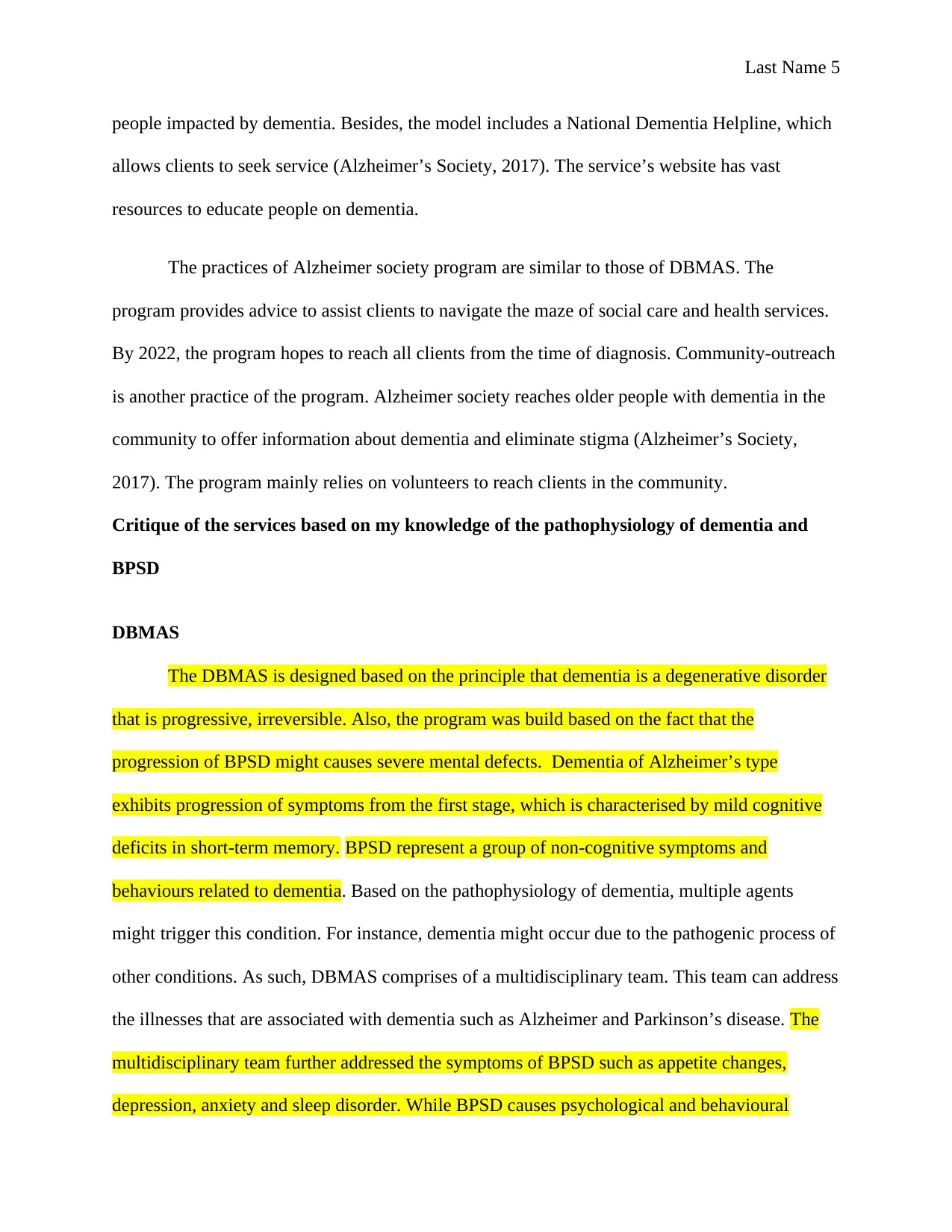
Last Name 5
people impacted by dementia. Besides, the model includes a National Dementia Helpline, which
allows clients to seek service (Alzheimer’s Society, 2017). The service’s website has vast
resources to educate people on dementia.
The practices of Alzheimer society program are similar to those of DBMAS. The
program provides advice to assist clients to navigate the maze of social care and health services.
By 2022, the program hopes to reach all clients from the time of diagnosis. Community-outreach
is another practice of the program. Alzheimer society reaches older people with dementia in the
community to offer information about dementia and eliminate stigma (Alzheimer’s Society,
2017). The program mainly relies on volunteers to reach clients in the community.
Critique of the services based on my knowledge of the pathophysiology of dementia and
BPSD
DBMAS
The DBMAS is designed based on the principle that dementia is a degenerative disorder
that is progressive, irreversible. Also, the program was build based on the fact that the
progression of BPSD might causes severe mental defects. Dementia of Alzheimer’s type
exhibits progression of symptoms from the first stage, which is characterised by mild cognitive
deficits in short-term memory. BPSD represent a group of non-cognitive symptoms and
behaviours related to dementia. Based on the pathophysiology of dementia, multiple agents
might trigger this condition. For instance, dementia might occur due to the pathogenic process of
other conditions. As such, DBMAS comprises of a multidisciplinary team. This team can address
the illnesses that are associated with dementia such as Alzheimer and Parkinson’s disease. The
multidisciplinary team further addressed the symptoms of BPSD such as appetite changes,
depression, anxiety and sleep disorder. While BPSD causes psychological and behavioural
people impacted by dementia. Besides, the model includes a National Dementia Helpline, which
allows clients to seek service (Alzheimer’s Society, 2017). The service’s website has vast
resources to educate people on dementia.
The practices of Alzheimer society program are similar to those of DBMAS. The
program provides advice to assist clients to navigate the maze of social care and health services.
By 2022, the program hopes to reach all clients from the time of diagnosis. Community-outreach
is another practice of the program. Alzheimer society reaches older people with dementia in the
community to offer information about dementia and eliminate stigma (Alzheimer’s Society,
2017). The program mainly relies on volunteers to reach clients in the community.
Critique of the services based on my knowledge of the pathophysiology of dementia and
BPSD
DBMAS
The DBMAS is designed based on the principle that dementia is a degenerative disorder
that is progressive, irreversible. Also, the program was build based on the fact that the
progression of BPSD might causes severe mental defects. Dementia of Alzheimer’s type
exhibits progression of symptoms from the first stage, which is characterised by mild cognitive
deficits in short-term memory. BPSD represent a group of non-cognitive symptoms and
behaviours related to dementia. Based on the pathophysiology of dementia, multiple agents
might trigger this condition. For instance, dementia might occur due to the pathogenic process of
other conditions. As such, DBMAS comprises of a multidisciplinary team. This team can address
the illnesses that are associated with dementia such as Alzheimer and Parkinson’s disease. The
multidisciplinary team further addressed the symptoms of BPSD such as appetite changes,
depression, anxiety and sleep disorder. While BPSD causes psychological and behavioural
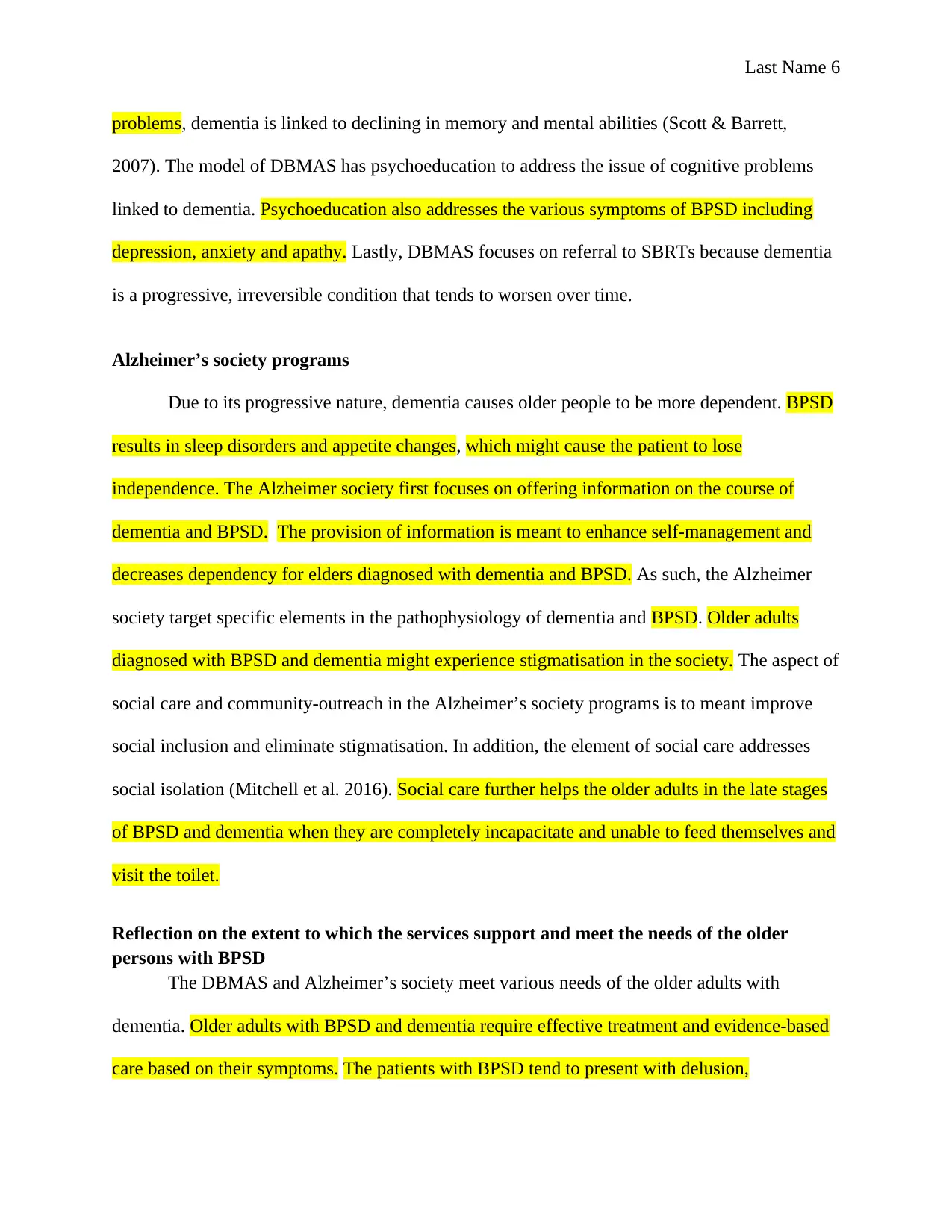
Last Name 6
problems, dementia is linked to declining in memory and mental abilities (Scott & Barrett,
2007). The model of DBMAS has psychoeducation to address the issue of cognitive problems
linked to dementia. Psychoeducation also addresses the various symptoms of BPSD including
depression, anxiety and apathy. Lastly, DBMAS focuses on referral to SBRTs because dementia
is a progressive, irreversible condition that tends to worsen over time.
Alzheimer’s society programs
Due to its progressive nature, dementia causes older people to be more dependent. BPSD
results in sleep disorders and appetite changes, which might cause the patient to lose
independence. The Alzheimer society first focuses on offering information on the course of
dementia and BPSD. The provision of information is meant to enhance self-management and
decreases dependency for elders diagnosed with dementia and BPSD. As such, the Alzheimer
society target specific elements in the pathophysiology of dementia and BPSD. Older adults
diagnosed with BPSD and dementia might experience stigmatisation in the society. The aspect of
social care and community-outreach in the Alzheimer’s society programs is to meant improve
social inclusion and eliminate stigmatisation. In addition, the element of social care addresses
social isolation (Mitchell et al. 2016). Social care further helps the older adults in the late stages
of BPSD and dementia when they are completely incapacitate and unable to feed themselves and
visit the toilet.
Reflection on the extent to which the services support and meet the needs of the older
persons with BPSD
The DBMAS and Alzheimer’s society meet various needs of the older adults with
dementia. Older adults with BPSD and dementia require effective treatment and evidence-based
care based on their symptoms. The patients with BPSD tend to present with delusion,
problems, dementia is linked to declining in memory and mental abilities (Scott & Barrett,
2007). The model of DBMAS has psychoeducation to address the issue of cognitive problems
linked to dementia. Psychoeducation also addresses the various symptoms of BPSD including
depression, anxiety and apathy. Lastly, DBMAS focuses on referral to SBRTs because dementia
is a progressive, irreversible condition that tends to worsen over time.
Alzheimer’s society programs
Due to its progressive nature, dementia causes older people to be more dependent. BPSD
results in sleep disorders and appetite changes, which might cause the patient to lose
independence. The Alzheimer society first focuses on offering information on the course of
dementia and BPSD. The provision of information is meant to enhance self-management and
decreases dependency for elders diagnosed with dementia and BPSD. As such, the Alzheimer
society target specific elements in the pathophysiology of dementia and BPSD. Older adults
diagnosed with BPSD and dementia might experience stigmatisation in the society. The aspect of
social care and community-outreach in the Alzheimer’s society programs is to meant improve
social inclusion and eliminate stigmatisation. In addition, the element of social care addresses
social isolation (Mitchell et al. 2016). Social care further helps the older adults in the late stages
of BPSD and dementia when they are completely incapacitate and unable to feed themselves and
visit the toilet.
Reflection on the extent to which the services support and meet the needs of the older
persons with BPSD
The DBMAS and Alzheimer’s society meet various needs of the older adults with
dementia. Older adults with BPSD and dementia require effective treatment and evidence-based
care based on their symptoms. The patients with BPSD tend to present with delusion,
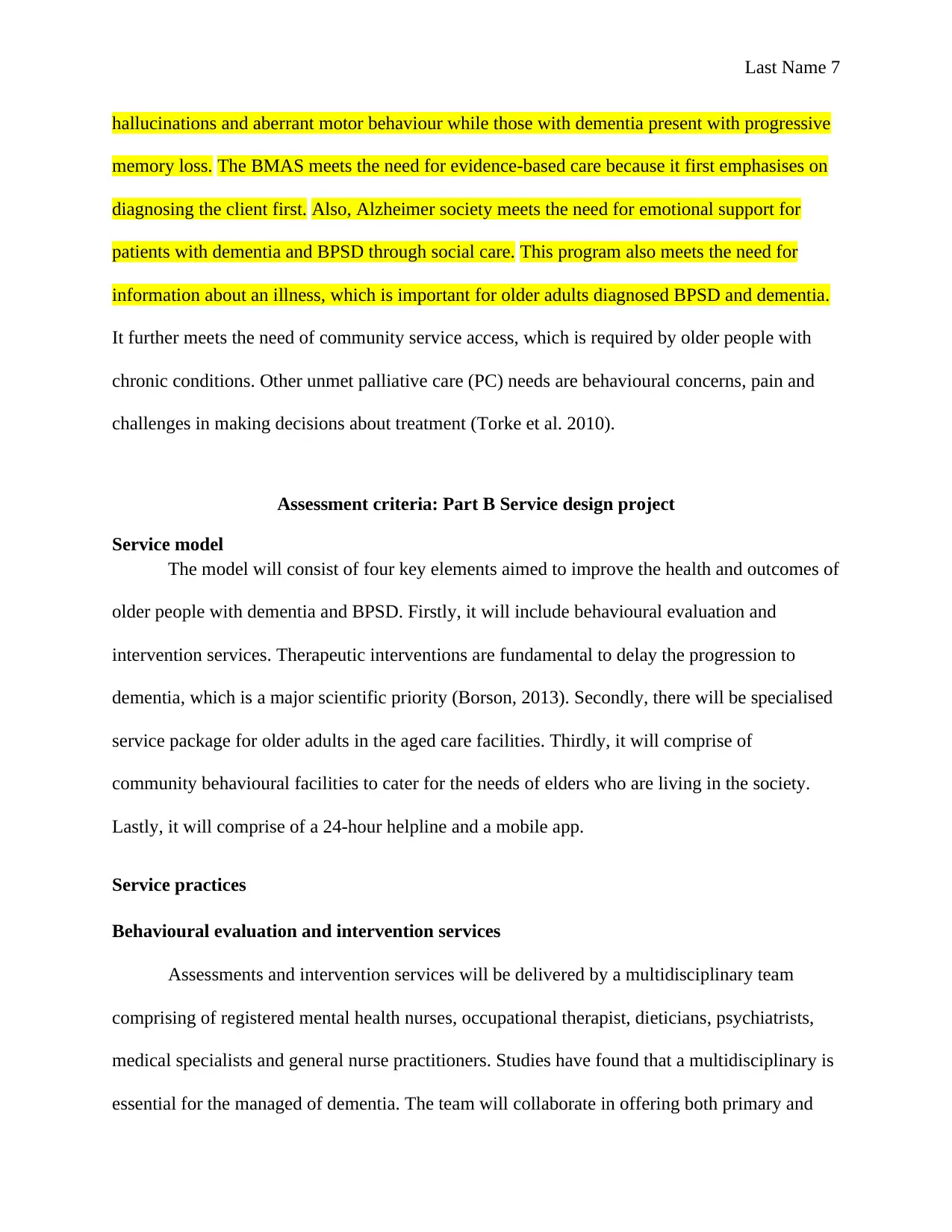
Last Name 7
hallucinations and aberrant motor behaviour while those with dementia present with progressive
memory loss. The BMAS meets the need for evidence-based care because it first emphasises on
diagnosing the client first. Also, Alzheimer society meets the need for emotional support for
patients with dementia and BPSD through social care. This program also meets the need for
information about an illness, which is important for older adults diagnosed BPSD and dementia.
It further meets the need of community service access, which is required by older people with
chronic conditions. Other unmet palliative care (PC) needs are behavioural concerns, pain and
challenges in making decisions about treatment (Torke et al. 2010).
Assessment criteria: Part B Service design project
Service model
The model will consist of four key elements aimed to improve the health and outcomes of
older people with dementia and BPSD. Firstly, it will include behavioural evaluation and
intervention services. Therapeutic interventions are fundamental to delay the progression to
dementia, which is a major scientific priority (Borson, 2013). Secondly, there will be specialised
service package for older adults in the aged care facilities. Thirdly, it will comprise of
community behavioural facilities to cater for the needs of elders who are living in the society.
Lastly, it will comprise of a 24-hour helpline and a mobile app.
Service practices
Behavioural evaluation and intervention services
Assessments and intervention services will be delivered by a multidisciplinary team
comprising of registered mental health nurses, occupational therapist, dieticians, psychiatrists,
medical specialists and general nurse practitioners. Studies have found that a multidisciplinary is
essential for the managed of dementia. The team will collaborate in offering both primary and
hallucinations and aberrant motor behaviour while those with dementia present with progressive
memory loss. The BMAS meets the need for evidence-based care because it first emphasises on
diagnosing the client first. Also, Alzheimer society meets the need for emotional support for
patients with dementia and BPSD through social care. This program also meets the need for
information about an illness, which is important for older adults diagnosed BPSD and dementia.
It further meets the need of community service access, which is required by older people with
chronic conditions. Other unmet palliative care (PC) needs are behavioural concerns, pain and
challenges in making decisions about treatment (Torke et al. 2010).
Assessment criteria: Part B Service design project
Service model
The model will consist of four key elements aimed to improve the health and outcomes of
older people with dementia and BPSD. Firstly, it will include behavioural evaluation and
intervention services. Therapeutic interventions are fundamental to delay the progression to
dementia, which is a major scientific priority (Borson, 2013). Secondly, there will be specialised
service package for older adults in the aged care facilities. Thirdly, it will comprise of
community behavioural facilities to cater for the needs of elders who are living in the society.
Lastly, it will comprise of a 24-hour helpline and a mobile app.
Service practices
Behavioural evaluation and intervention services
Assessments and intervention services will be delivered by a multidisciplinary team
comprising of registered mental health nurses, occupational therapist, dieticians, psychiatrists,
medical specialists and general nurse practitioners. Studies have found that a multidisciplinary is
essential for the managed of dementia. The team will collaborate in offering both primary and
Paraphrase This Document
Need a fresh take? Get an instant paraphrase of this document with our AI Paraphraser
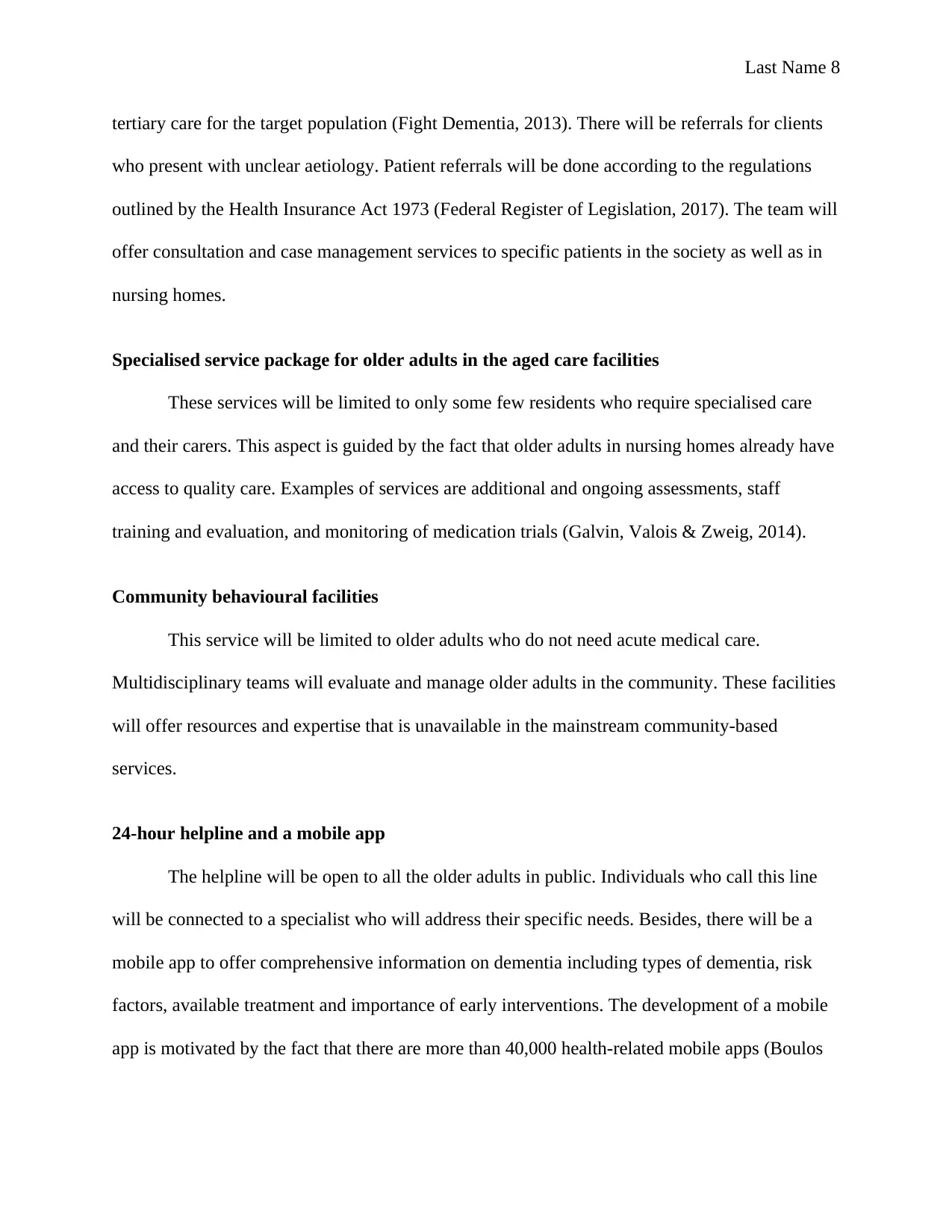
Last Name 8
tertiary care for the target population (Fight Dementia, 2013). There will be referrals for clients
who present with unclear aetiology. Patient referrals will be done according to the regulations
outlined by the Health Insurance Act 1973 (Federal Register of Legislation, 2017). The team will
offer consultation and case management services to specific patients in the society as well as in
nursing homes.
Specialised service package for older adults in the aged care facilities
These services will be limited to only some few residents who require specialised care
and their carers. This aspect is guided by the fact that older adults in nursing homes already have
access to quality care. Examples of services are additional and ongoing assessments, staff
training and evaluation, and monitoring of medication trials (Galvin, Valois & Zweig, 2014).
Community behavioural facilities
This service will be limited to older adults who do not need acute medical care.
Multidisciplinary teams will evaluate and manage older adults in the community. These facilities
will offer resources and expertise that is unavailable in the mainstream community-based
services.
24-hour helpline and a mobile app
The helpline will be open to all the older adults in public. Individuals who call this line
will be connected to a specialist who will address their specific needs. Besides, there will be a
mobile app to offer comprehensive information on dementia including types of dementia, risk
factors, available treatment and importance of early interventions. The development of a mobile
app is motivated by the fact that there are more than 40,000 health-related mobile apps (Boulos
tertiary care for the target population (Fight Dementia, 2013). There will be referrals for clients
who present with unclear aetiology. Patient referrals will be done according to the regulations
outlined by the Health Insurance Act 1973 (Federal Register of Legislation, 2017). The team will
offer consultation and case management services to specific patients in the society as well as in
nursing homes.
Specialised service package for older adults in the aged care facilities
These services will be limited to only some few residents who require specialised care
and their carers. This aspect is guided by the fact that older adults in nursing homes already have
access to quality care. Examples of services are additional and ongoing assessments, staff
training and evaluation, and monitoring of medication trials (Galvin, Valois & Zweig, 2014).
Community behavioural facilities
This service will be limited to older adults who do not need acute medical care.
Multidisciplinary teams will evaluate and manage older adults in the community. These facilities
will offer resources and expertise that is unavailable in the mainstream community-based
services.
24-hour helpline and a mobile app
The helpline will be open to all the older adults in public. Individuals who call this line
will be connected to a specialist who will address their specific needs. Besides, there will be a
mobile app to offer comprehensive information on dementia including types of dementia, risk
factors, available treatment and importance of early interventions. The development of a mobile
app is motivated by the fact that there are more than 40,000 health-related mobile apps (Boulos
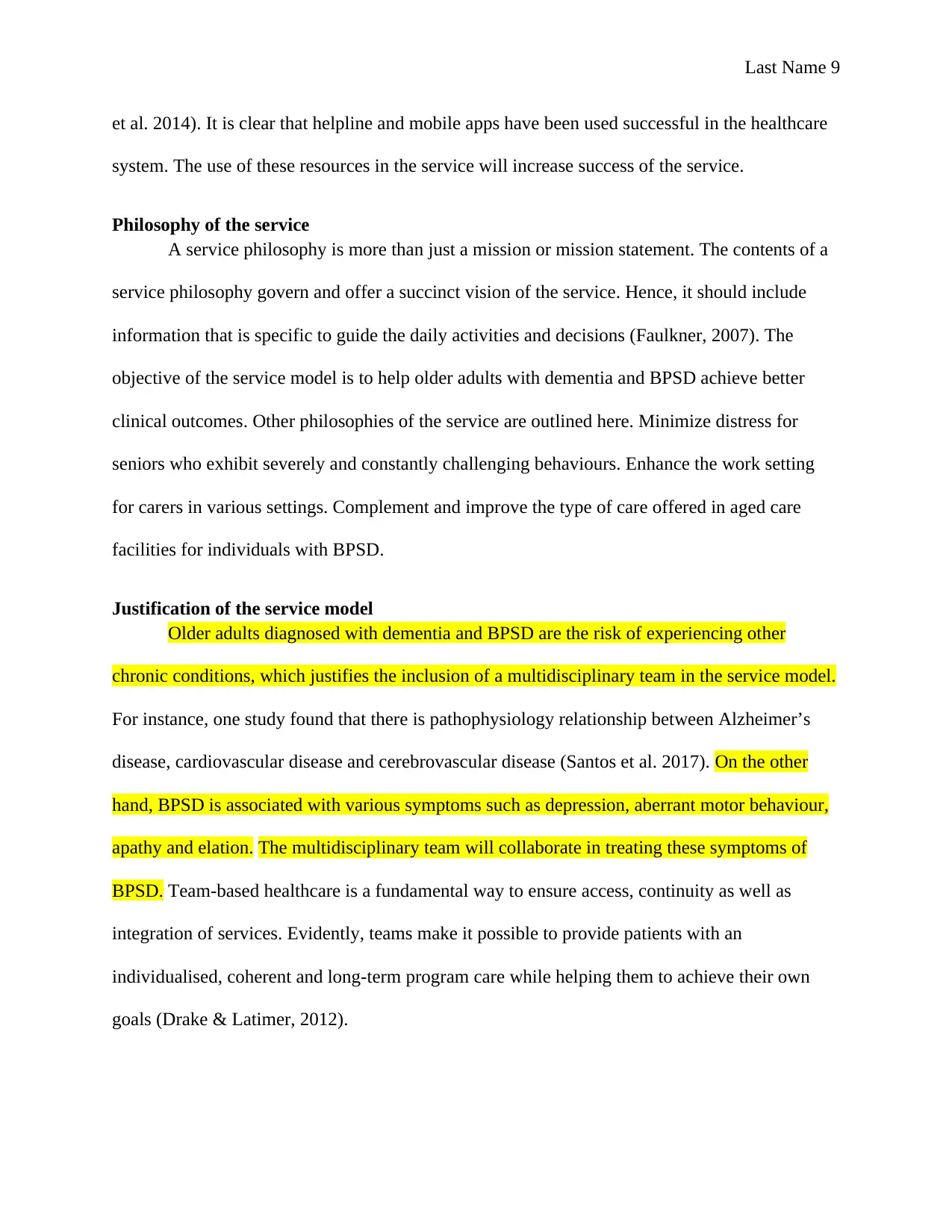
Last Name 9
et al. 2014). It is clear that helpline and mobile apps have been used successful in the healthcare
system. The use of these resources in the service will increase success of the service.
Philosophy of the service
A service philosophy is more than just a mission or mission statement. The contents of a
service philosophy govern and offer a succinct vision of the service. Hence, it should include
information that is specific to guide the daily activities and decisions (Faulkner, 2007). The
objective of the service model is to help older adults with dementia and BPSD achieve better
clinical outcomes. Other philosophies of the service are outlined here. Minimize distress for
seniors who exhibit severely and constantly challenging behaviours. Enhance the work setting
for carers in various settings. Complement and improve the type of care offered in aged care
facilities for individuals with BPSD.
Justification of the service model
Older adults diagnosed with dementia and BPSD are the risk of experiencing other
chronic conditions, which justifies the inclusion of a multidisciplinary team in the service model.
For instance, one study found that there is pathophysiology relationship between Alzheimer’s
disease, cardiovascular disease and cerebrovascular disease (Santos et al. 2017). On the other
hand, BPSD is associated with various symptoms such as depression, aberrant motor behaviour,
apathy and elation. The multidisciplinary team will collaborate in treating these symptoms of
BPSD. Team-based healthcare is a fundamental way to ensure access, continuity as well as
integration of services. Evidently, teams make it possible to provide patients with an
individualised, coherent and long-term program care while helping them to achieve their own
goals (Drake & Latimer, 2012).
et al. 2014). It is clear that helpline and mobile apps have been used successful in the healthcare
system. The use of these resources in the service will increase success of the service.
Philosophy of the service
A service philosophy is more than just a mission or mission statement. The contents of a
service philosophy govern and offer a succinct vision of the service. Hence, it should include
information that is specific to guide the daily activities and decisions (Faulkner, 2007). The
objective of the service model is to help older adults with dementia and BPSD achieve better
clinical outcomes. Other philosophies of the service are outlined here. Minimize distress for
seniors who exhibit severely and constantly challenging behaviours. Enhance the work setting
for carers in various settings. Complement and improve the type of care offered in aged care
facilities for individuals with BPSD.
Justification of the service model
Older adults diagnosed with dementia and BPSD are the risk of experiencing other
chronic conditions, which justifies the inclusion of a multidisciplinary team in the service model.
For instance, one study found that there is pathophysiology relationship between Alzheimer’s
disease, cardiovascular disease and cerebrovascular disease (Santos et al. 2017). On the other
hand, BPSD is associated with various symptoms such as depression, aberrant motor behaviour,
apathy and elation. The multidisciplinary team will collaborate in treating these symptoms of
BPSD. Team-based healthcare is a fundamental way to ensure access, continuity as well as
integration of services. Evidently, teams make it possible to provide patients with an
individualised, coherent and long-term program care while helping them to achieve their own
goals (Drake & Latimer, 2012).
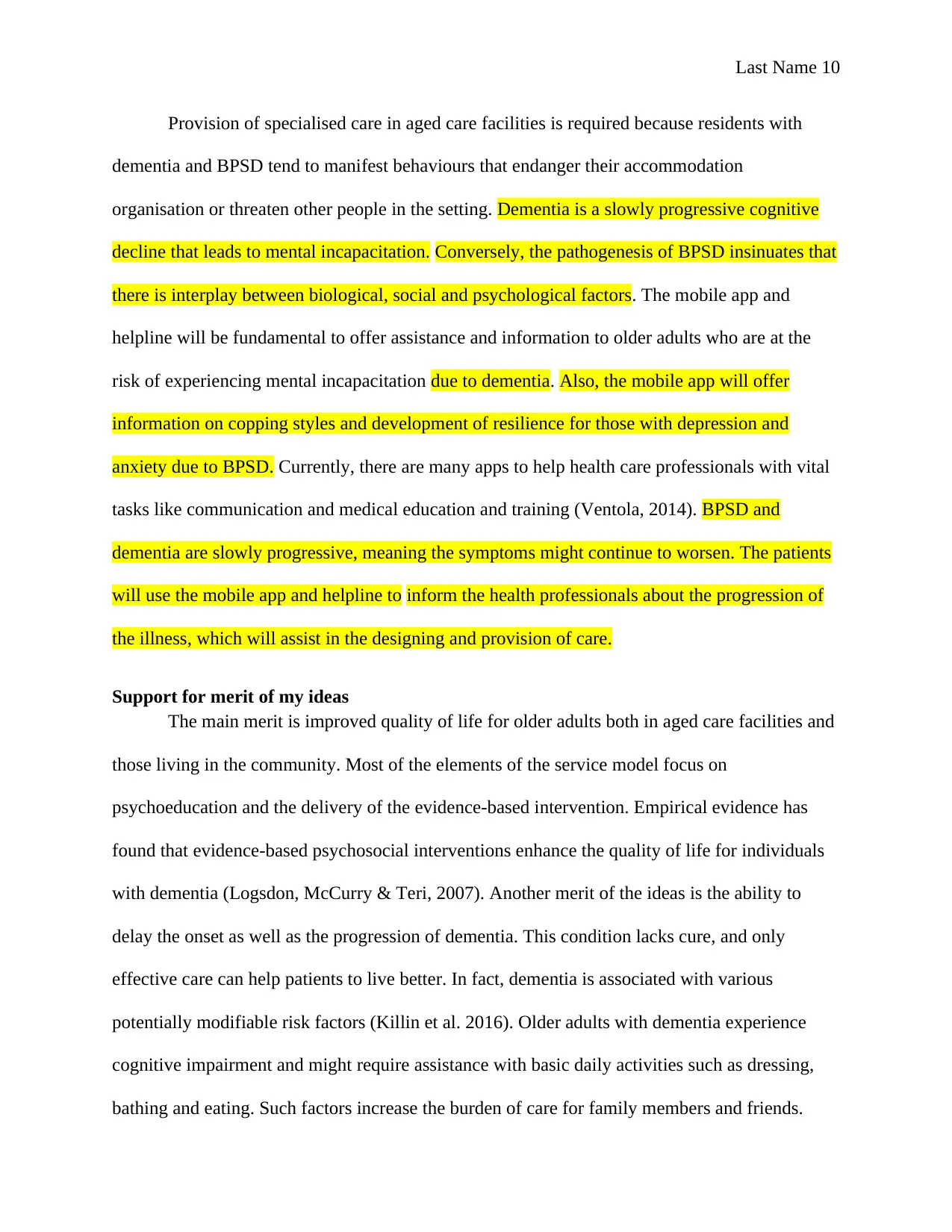
Last Name 10
Provision of specialised care in aged care facilities is required because residents with
dementia and BPSD tend to manifest behaviours that endanger their accommodation
organisation or threaten other people in the setting. Dementia is a slowly progressive cognitive
decline that leads to mental incapacitation. Conversely, the pathogenesis of BPSD insinuates that
there is interplay between biological, social and psychological factors. The mobile app and
helpline will be fundamental to offer assistance and information to older adults who are at the
risk of experiencing mental incapacitation due to dementia. Also, the mobile app will offer
information on copping styles and development of resilience for those with depression and
anxiety due to BPSD. Currently, there are many apps to help health care professionals with vital
tasks like communication and medical education and training (Ventola, 2014). BPSD and
dementia are slowly progressive, meaning the symptoms might continue to worsen. The patients
will use the mobile app and helpline to inform the health professionals about the progression of
the illness, which will assist in the designing and provision of care.
Support for merit of my ideas
The main merit is improved quality of life for older adults both in aged care facilities and
those living in the community. Most of the elements of the service model focus on
psychoeducation and the delivery of the evidence-based intervention. Empirical evidence has
found that evidence-based psychosocial interventions enhance the quality of life for individuals
with dementia (Logsdon, McCurry & Teri, 2007). Another merit of the ideas is the ability to
delay the onset as well as the progression of dementia. This condition lacks cure, and only
effective care can help patients to live better. In fact, dementia is associated with various
potentially modifiable risk factors (Killin et al. 2016). Older adults with dementia experience
cognitive impairment and might require assistance with basic daily activities such as dressing,
bathing and eating. Such factors increase the burden of care for family members and friends.
Provision of specialised care in aged care facilities is required because residents with
dementia and BPSD tend to manifest behaviours that endanger their accommodation
organisation or threaten other people in the setting. Dementia is a slowly progressive cognitive
decline that leads to mental incapacitation. Conversely, the pathogenesis of BPSD insinuates that
there is interplay between biological, social and psychological factors. The mobile app and
helpline will be fundamental to offer assistance and information to older adults who are at the
risk of experiencing mental incapacitation due to dementia. Also, the mobile app will offer
information on copping styles and development of resilience for those with depression and
anxiety due to BPSD. Currently, there are many apps to help health care professionals with vital
tasks like communication and medical education and training (Ventola, 2014). BPSD and
dementia are slowly progressive, meaning the symptoms might continue to worsen. The patients
will use the mobile app and helpline to inform the health professionals about the progression of
the illness, which will assist in the designing and provision of care.
Support for merit of my ideas
The main merit is improved quality of life for older adults both in aged care facilities and
those living in the community. Most of the elements of the service model focus on
psychoeducation and the delivery of the evidence-based intervention. Empirical evidence has
found that evidence-based psychosocial interventions enhance the quality of life for individuals
with dementia (Logsdon, McCurry & Teri, 2007). Another merit of the ideas is the ability to
delay the onset as well as the progression of dementia. This condition lacks cure, and only
effective care can help patients to live better. In fact, dementia is associated with various
potentially modifiable risk factors (Killin et al. 2016). Older adults with dementia experience
cognitive impairment and might require assistance with basic daily activities such as dressing,
bathing and eating. Such factors increase the burden of care for family members and friends.
Secure Best Marks with AI Grader
Need help grading? Try our AI Grader for instant feedback on your assignments.

Last Name 11
Thus, delaying the onset of dementia would have significant benefits on the patient, family
members and health care system. Besides, dementia is associated with financial burned to the
family and health care system. The financial burned is high for patients who require specialised
care and treatment for other medical conditions (Zissimopoulos, Crimmins & Clair, 2014). The
ideas will help to improve the condition of the patients, which will consequently lower the
financial burden for the cares.
Thus, delaying the onset of dementia would have significant benefits on the patient, family
members and health care system. Besides, dementia is associated with financial burned to the
family and health care system. The financial burned is high for patients who require specialised
care and treatment for other medical conditions (Zissimopoulos, Crimmins & Clair, 2014). The
ideas will help to improve the condition of the patients, which will consequently lower the
financial burden for the cares.
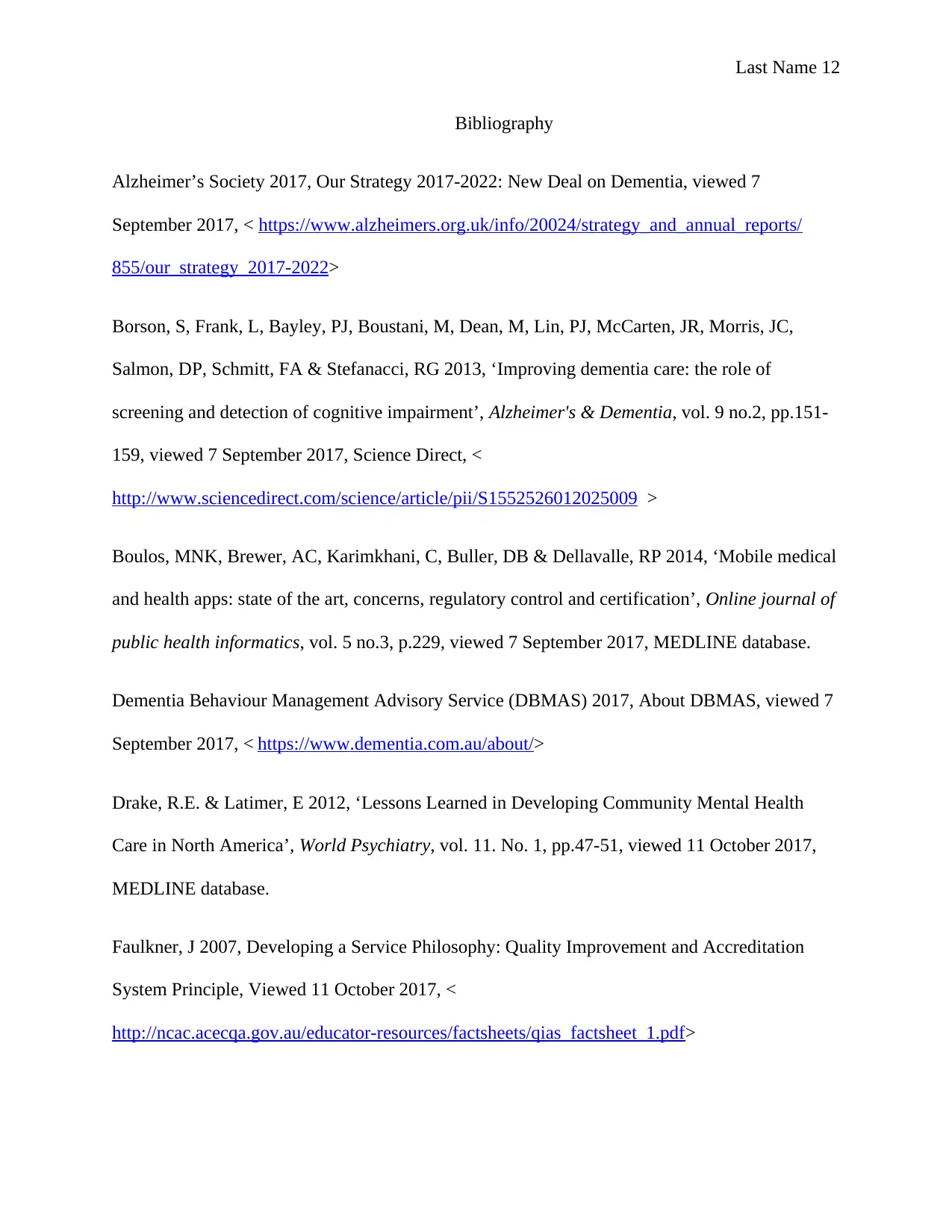
Last Name 12
Bibliography
Alzheimer’s Society 2017, Our Strategy 2017-2022: New Deal on Dementia, viewed 7
September 2017, < https://www.alzheimers.org.uk/info/20024/strategy_and_annual_reports/
855/our_strategy_2017-2022>
Borson, S, Frank, L, Bayley, PJ, Boustani, M, Dean, M, Lin, PJ, McCarten, JR, Morris, JC,
Salmon, DP, Schmitt, FA & Stefanacci, RG 2013, ‘Improving dementia care: the role of
screening and detection of cognitive impairment’, Alzheimer's & Dementia, vol. 9 no.2, pp.151-
159, viewed 7 September 2017, Science Direct, <
http://www.sciencedirect.com/science/article/pii/S1552526012025009 >
Boulos, MNK, Brewer, AC, Karimkhani, C, Buller, DB & Dellavalle, RP 2014, ‘Mobile medical
and health apps: state of the art, concerns, regulatory control and certification’, Online journal of
public health informatics, vol. 5 no.3, p.229, viewed 7 September 2017, MEDLINE database.
Dementia Behaviour Management Advisory Service (DBMAS) 2017, About DBMAS, viewed 7
September 2017, < https://www.dementia.com.au/about/>
Drake, R.E. & Latimer, E 2012, ‘Lessons Learned in Developing Community Mental Health
Care in North America’, World Psychiatry, vol. 11. No. 1, pp.47-51, viewed 11 October 2017,
MEDLINE database.
Faulkner, J 2007, Developing a Service Philosophy: Quality Improvement and Accreditation
System Principle, Viewed 11 October 2017, <
http://ncac.acecqa.gov.au/educator-resources/factsheets/qias_factsheet_1.pdf>
Bibliography
Alzheimer’s Society 2017, Our Strategy 2017-2022: New Deal on Dementia, viewed 7
September 2017, < https://www.alzheimers.org.uk/info/20024/strategy_and_annual_reports/
855/our_strategy_2017-2022>
Borson, S, Frank, L, Bayley, PJ, Boustani, M, Dean, M, Lin, PJ, McCarten, JR, Morris, JC,
Salmon, DP, Schmitt, FA & Stefanacci, RG 2013, ‘Improving dementia care: the role of
screening and detection of cognitive impairment’, Alzheimer's & Dementia, vol. 9 no.2, pp.151-
159, viewed 7 September 2017, Science Direct, <
http://www.sciencedirect.com/science/article/pii/S1552526012025009 >
Boulos, MNK, Brewer, AC, Karimkhani, C, Buller, DB & Dellavalle, RP 2014, ‘Mobile medical
and health apps: state of the art, concerns, regulatory control and certification’, Online journal of
public health informatics, vol. 5 no.3, p.229, viewed 7 September 2017, MEDLINE database.
Dementia Behaviour Management Advisory Service (DBMAS) 2017, About DBMAS, viewed 7
September 2017, < https://www.dementia.com.au/about/>
Drake, R.E. & Latimer, E 2012, ‘Lessons Learned in Developing Community Mental Health
Care in North America’, World Psychiatry, vol. 11. No. 1, pp.47-51, viewed 11 October 2017,
MEDLINE database.
Faulkner, J 2007, Developing a Service Philosophy: Quality Improvement and Accreditation
System Principle, Viewed 11 October 2017, <
http://ncac.acecqa.gov.au/educator-resources/factsheets/qias_factsheet_1.pdf>
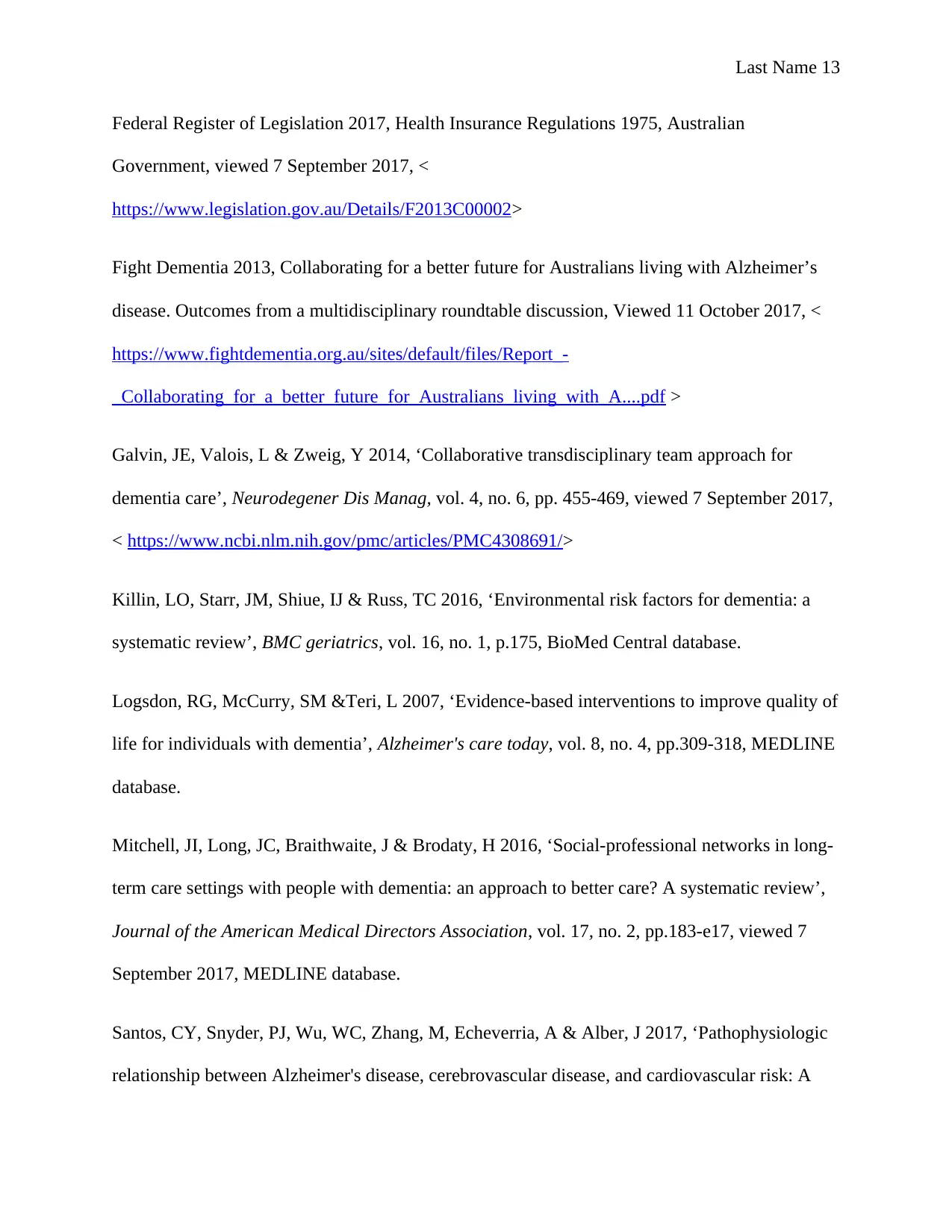
Last Name 13
Federal Register of Legislation 2017, Health Insurance Regulations 1975, Australian
Government, viewed 7 September 2017, <
https://www.legislation.gov.au/Details/F2013C00002>
Fight Dementia 2013, Collaborating for a better future for Australians living with Alzheimer’s
disease. Outcomes from a multidisciplinary roundtable discussion, Viewed 11 October 2017, <
https://www.fightdementia.org.au/sites/default/files/Report_-
_Collaborating_for_a_better_future_for_Australians_living_with_A....pdf >
Galvin, JE, Valois, L & Zweig, Y 2014, ‘Collaborative transdisciplinary team approach for
dementia care’, Neurodegener Dis Manag, vol. 4, no. 6, pp. 455-469, viewed 7 September 2017,
< https://www.ncbi.nlm.nih.gov/pmc/articles/PMC4308691/>
Killin, LO, Starr, JM, Shiue, IJ & Russ, TC 2016, ‘Environmental risk factors for dementia: a
systematic review’, BMC geriatrics, vol. 16, no. 1, p.175, BioMed Central database.
Logsdon, RG, McCurry, SM &Teri, L 2007, ‘Evidence-based interventions to improve quality of
life for individuals with dementia’, Alzheimer's care today, vol. 8, no. 4, pp.309-318, MEDLINE
database.
Mitchell, JI, Long, JC, Braithwaite, J & Brodaty, H 2016, ‘Social-professional networks in long-
term care settings with people with dementia: an approach to better care? A systematic review’,
Journal of the American Medical Directors Association, vol. 17, no. 2, pp.183-e17, viewed 7
September 2017, MEDLINE database.
Santos, CY, Snyder, PJ, Wu, WC, Zhang, M, Echeverria, A & Alber, J 2017, ‘Pathophysiologic
relationship between Alzheimer's disease, cerebrovascular disease, and cardiovascular risk: A
Federal Register of Legislation 2017, Health Insurance Regulations 1975, Australian
Government, viewed 7 September 2017, <
https://www.legislation.gov.au/Details/F2013C00002>
Fight Dementia 2013, Collaborating for a better future for Australians living with Alzheimer’s
disease. Outcomes from a multidisciplinary roundtable discussion, Viewed 11 October 2017, <
https://www.fightdementia.org.au/sites/default/files/Report_-
_Collaborating_for_a_better_future_for_Australians_living_with_A....pdf >
Galvin, JE, Valois, L & Zweig, Y 2014, ‘Collaborative transdisciplinary team approach for
dementia care’, Neurodegener Dis Manag, vol. 4, no. 6, pp. 455-469, viewed 7 September 2017,
< https://www.ncbi.nlm.nih.gov/pmc/articles/PMC4308691/>
Killin, LO, Starr, JM, Shiue, IJ & Russ, TC 2016, ‘Environmental risk factors for dementia: a
systematic review’, BMC geriatrics, vol. 16, no. 1, p.175, BioMed Central database.
Logsdon, RG, McCurry, SM &Teri, L 2007, ‘Evidence-based interventions to improve quality of
life for individuals with dementia’, Alzheimer's care today, vol. 8, no. 4, pp.309-318, MEDLINE
database.
Mitchell, JI, Long, JC, Braithwaite, J & Brodaty, H 2016, ‘Social-professional networks in long-
term care settings with people with dementia: an approach to better care? A systematic review’,
Journal of the American Medical Directors Association, vol. 17, no. 2, pp.183-e17, viewed 7
September 2017, MEDLINE database.
Santos, CY, Snyder, PJ, Wu, WC, Zhang, M, Echeverria, A & Alber, J 2017, ‘Pathophysiologic
relationship between Alzheimer's disease, cerebrovascular disease, and cardiovascular risk: A
Paraphrase This Document
Need a fresh take? Get an instant paraphrase of this document with our AI Paraphraser
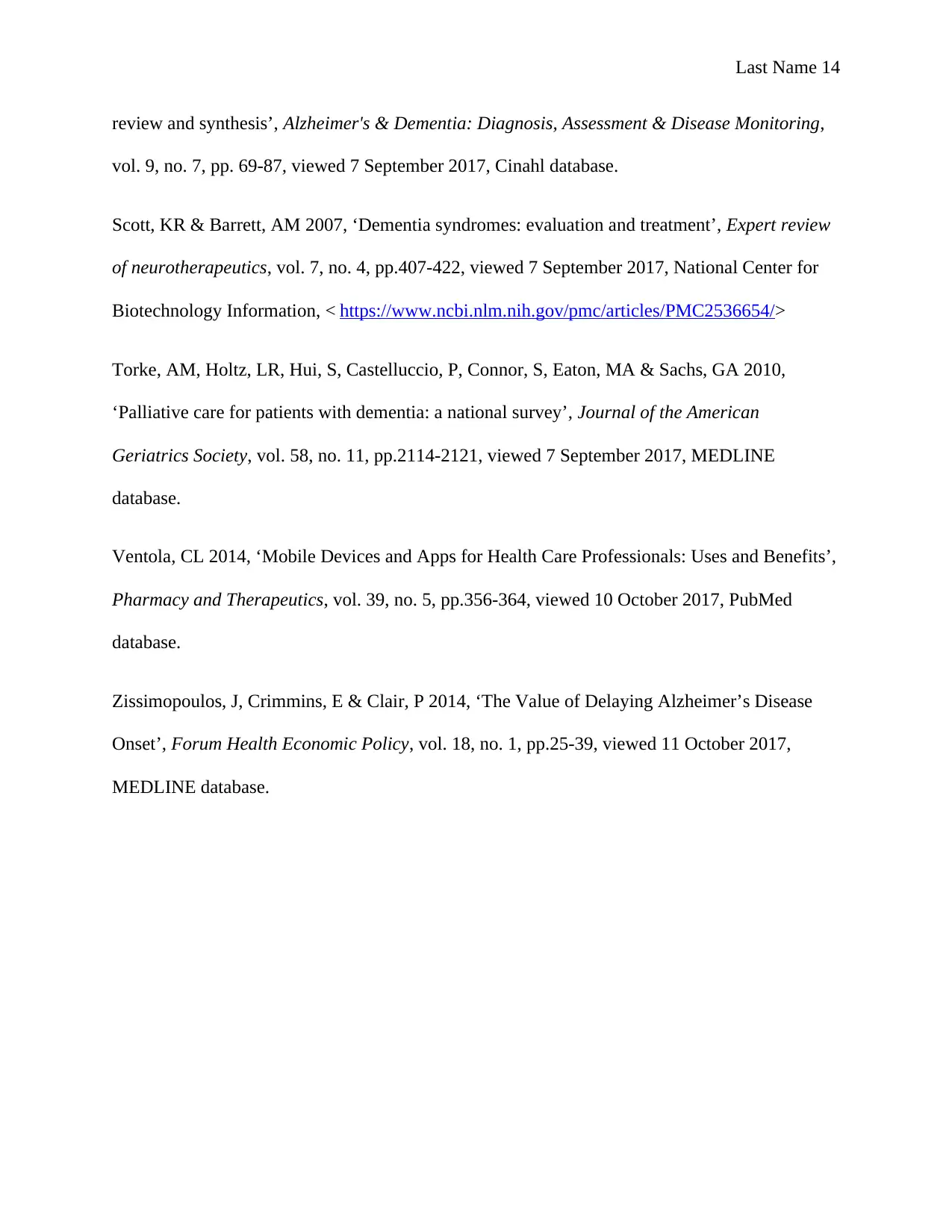
Last Name 14
review and synthesis’, Alzheimer's & Dementia: Diagnosis, Assessment & Disease Monitoring,
vol. 9, no. 7, pp. 69-87, viewed 7 September 2017, Cinahl database.
Scott, KR & Barrett, AM 2007, ‘Dementia syndromes: evaluation and treatment’, Expert review
of neurotherapeutics, vol. 7, no. 4, pp.407-422, viewed 7 September 2017, National Center for
Biotechnology Information, < https://www.ncbi.nlm.nih.gov/pmc/articles/PMC2536654/>
Torke, AM, Holtz, LR, Hui, S, Castelluccio, P, Connor, S, Eaton, MA & Sachs, GA 2010,
‘Palliative care for patients with dementia: a national survey’, Journal of the American
Geriatrics Society, vol. 58, no. 11, pp.2114-2121, viewed 7 September 2017, MEDLINE
database.
Ventola, CL 2014, ‘Mobile Devices and Apps for Health Care Professionals: Uses and Benefits’,
Pharmacy and Therapeutics, vol. 39, no. 5, pp.356-364, viewed 10 October 2017, PubMed
database.
Zissimopoulos, J, Crimmins, E & Clair, P 2014, ‘The Value of Delaying Alzheimer’s Disease
Onset’, Forum Health Economic Policy, vol. 18, no. 1, pp.25-39, viewed 11 October 2017,
MEDLINE database.
review and synthesis’, Alzheimer's & Dementia: Diagnosis, Assessment & Disease Monitoring,
vol. 9, no. 7, pp. 69-87, viewed 7 September 2017, Cinahl database.
Scott, KR & Barrett, AM 2007, ‘Dementia syndromes: evaluation and treatment’, Expert review
of neurotherapeutics, vol. 7, no. 4, pp.407-422, viewed 7 September 2017, National Center for
Biotechnology Information, < https://www.ncbi.nlm.nih.gov/pmc/articles/PMC2536654/>
Torke, AM, Holtz, LR, Hui, S, Castelluccio, P, Connor, S, Eaton, MA & Sachs, GA 2010,
‘Palliative care for patients with dementia: a national survey’, Journal of the American
Geriatrics Society, vol. 58, no. 11, pp.2114-2121, viewed 7 September 2017, MEDLINE
database.
Ventola, CL 2014, ‘Mobile Devices and Apps for Health Care Professionals: Uses and Benefits’,
Pharmacy and Therapeutics, vol. 39, no. 5, pp.356-364, viewed 10 October 2017, PubMed
database.
Zissimopoulos, J, Crimmins, E & Clair, P 2014, ‘The Value of Delaying Alzheimer’s Disease
Onset’, Forum Health Economic Policy, vol. 18, no. 1, pp.25-39, viewed 11 October 2017,
MEDLINE database.
1 out of 14
Related Documents
Your All-in-One AI-Powered Toolkit for Academic Success.
+13062052269
info@desklib.com
Available 24*7 on WhatsApp / Email
![[object Object]](/_next/static/media/star-bottom.7253800d.svg)
Unlock your academic potential
© 2024 | Zucol Services PVT LTD | All rights reserved.





